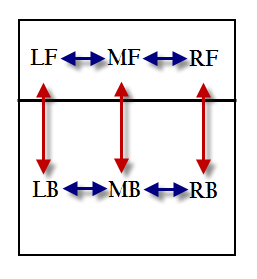OK coaches. Let’s talk volleyball overlap rule. We need to get things sorted out.
If we don’t accomplish anything else with our players, we should at least be able to teach them the rules of the game. Some of you out there are coming up a bit short in that regard. At least this is the case when it comes to the overlap rules. I keep coming across players who have some serious misconceptions.
It’s very simple folks.
Part 1 – A back row player cannot be closer to the net than the player immediately in front of them in the rotation. This means the player in 1 cannot be closer to the net than the player in 2. Same for the player in 6 and the one in 3, and for the player in 5 and the one in 4.
Part 2 – The middle player in a row must not be nearer to the left sideline than the left player or nearer to the right sideline than the right player. That means the player in 3 cannot be closer to the left sideline (looking toward the net) than the player in 4, or closer to the right sideline than the player in 2. Similarly, the player in 6 cannot be closer to the left sideline than the player in 5, or closer to the right sideline than the player in 1. The one exception is that if the player in 1 is serving. They are not technically in the court so there is no potential overlap.
See the diagram below for clarity.

Note, there is NO DIAGONAL OVERLAP!
See FIVB Rule 7.4. (page 25 of the linked PDF). Please note that how exactly overlap is judged based on foot position may not match what you think. See page 66 of the linked rules for diagrams.
Why does this come to mind? Because when I coached in Sweden I found out at least some of my players didn’t know the rules. This is in a professional league! I had a sneaking suspicion based on some little things I saw in a couple matches. One practice solidified it, though. We’re talking players with many years of experience. My team had members who played in the top US collegiate volleyball conferences and players who have represented their countries at the youth levels.
I ran into the same issue when I was coaching in Exeter. Admittedly, the experience level there was considerably more diverse and limited.
I even ran into this issue in the early years of my coaching with another member of the staff of the first NCAA Division I program I coached for. She had been an All-American in her playing days!
One other thing. It is until the actual contact of the ball that the overlap rules apply. That is considered the serve, not the toss.
Please, please can we commit ourselves to teaching our players the rules properly?
15 Responses
That is the reason why refs don’t call rotational faults anymore: they don’t know the overlap rule either 😀
I was under the impression if I pulled my 4 back into SR that she could not be behind either 6 or 1. If I understand your description correctly, that’s not the case. The only front row/back row overlap is the player directly in front of or behind you.
That’s exactly correct. Neither 6 nor 1 has any overlap considerations with respect to 4. Only 5 and 3.
I’m not endorsing a product but Rotate 123 has a good overlap rule visual on their website where you can drag players around the court and it will show where the overlaps occur and with which player. https://www.solostatslive.com/rotate-1231.html
I haven’t used that feature, but I am a regular user of Rotate123 for bench stats during matches.
John, I think you forgot one import ant point “when the serve is made” the players need to be in rotation.
Didn’t really forget it Greg. I honestly haven’t come across many at least modestly experienced folks who don’t realize ball contact is the deciding point. Different story with the overlap question, which is why that’s the focus here.
Do you know if on a jump serve you can cross after the ball has been thrown or must you wait until contact? I have received mixed responses on this question.
Tony – It doesn’t matter if it’s a jump serve or a standing serve. Players must be in the correct rotational position (not switched) at ball contact.
What if a player in 1 is standing on both sides of a player in 6? Rotation error?
Boozer – In that scenario the player in 1 is closer to the right sideline than the player in 6, which is the requirement, so no error.
What determines player position? Just their feet or any part of their body?
Michael – If you follow the link to the FIVB rule book you’ll see under 7.4.3 “The positions of players are determined and controlled according to the positions of their feet contacting the ground…”
Have you ever seen the double V serve receive where the LB is behind the RF?
I’m sure I have, though I’m having a hard time visualizing it.